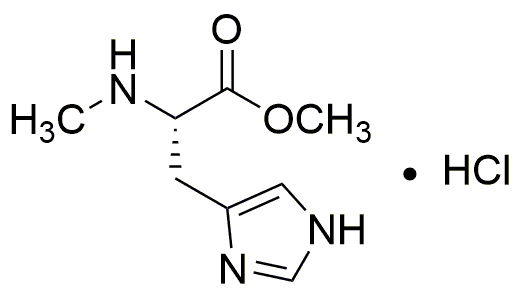Na-Methyl-L-histidine methyl ester hydrochloride is widely utilized in research focused on:
- Biochemical Studies: This compound serves as a valuable tool in studying histidine metabolism and its role in various biological processes, helping researchers understand its implications in health and disease.
- Drug Development: It is used in the pharmaceutical industry to develop new drugs targeting histamine-related pathways, potentially leading to innovative treatments for allergies and other conditions.
- Protein Research: The compound is instrumental in protein synthesis studies, allowing scientists to investigate the effects of methylation on protein function and stability.
- Nutrition and Dietary Supplements: It is explored in the formulation of dietary supplements aimed at enhancing athletic performance and recovery, appealing to fitness enthusiasts and athletes.
- Analytical Chemistry: This chemical is employed in various analytical techniques, such as chromatography, to separate and identify amino acids and peptides in complex mixtures, aiding quality control in food and pharmaceutical industries.
General Information
Properties
Safety and Regulations
Applications
Na-Methyl-L-histidine methyl ester hydrochloride is widely utilized in research focused on:
- Biochemical Studies: This compound serves as a valuable tool in studying histidine metabolism and its role in various biological processes, helping researchers understand its implications in health and disease.
- Drug Development: It is used in the pharmaceutical industry to develop new drugs targeting histamine-related pathways, potentially leading to innovative treatments for allergies and other conditions.
- Protein Research: The compound is instrumental in protein synthesis studies, allowing scientists to investigate the effects of methylation on protein function and stability.
- Nutrition and Dietary Supplements: It is explored in the formulation of dietary supplements aimed at enhancing athletic performance and recovery, appealing to fitness enthusiasts and athletes.
- Analytical Chemistry: This chemical is employed in various analytical techniques, such as chromatography, to separate and identify amino acids and peptides in complex mixtures, aiding quality control in food and pharmaceutical industries.
Documents
Safety Data Sheets (SDS)
The SDS provides comprehensive safety information on handling, storage, and disposal of the product.
Product Specification (PS)
The PS provides a comprehensive breakdown of the product’s properties, including chemical composition, physical state, purity, and storage requirements. It also details acceptable quality ranges and the product's intended applications.
Certificates of Analysis (COA)
Search for Certificates of Analysis (COA) by entering the products Lot Number. Lot and Batch Numbers can be found on a product’s label following the words ‘Lot’ or ‘Batch’.
Número de catálogo
Número de lote/lote
Certificates Of Origin (COO)
This COO confirms the country where the product was manufactured, and also details the materials and components used in it and whether it is derived from natural, synthetic, or other specific sources. This certificate may be required for customs, trade, and regulatory compliance.
Número de catálogo
Número de lote/lote
Safety Data Sheets (SDS)
The SDS provides comprehensive safety information on handling, storage, and disposal of the product.
DownloadProduct Specification (PS)
The PS provides a comprehensive breakdown of the product’s properties, including chemical composition, physical state, purity, and storage requirements. It also details acceptable quality ranges and the product's intended applications.
DownloadCertificates of Analysis (COA)
Search for Certificates of Analysis (COA) by entering the products Lot Number. Lot and Batch Numbers can be found on a product’s label following the words ‘Lot’ or ‘Batch’.
Número de catálogo
Número de lote/lote
Certificates Of Origin (COO)
This COO confirms the country where the product was manufactured, and also details the materials and components used in it and whether it is derived from natural, synthetic, or other specific sources. This certificate may be required for customs, trade, and regulatory compliance.


